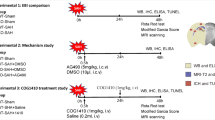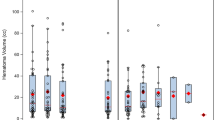Abstract
Introduction
Recent clinical observations demonstrate that the APOE4 genotype increases the development of delayed ischemic deficit and worsens prognosis following aneurysmal subarachnoid hemorrhage (SAH). In the current study, we use targeted replacement mice expressing only human apoE3 or apoE4 to model the isoform-specific effects of apoE following SAH. We then test the hypothesis that an apoE-derived therapeutic peptide reduces vasospasm and improves functional recovery after SAH.
Methods
Experimental SAH was induced in APOE3- and APOE4-targeted replacement mice. For 3 days following injury, daily functional assessments were made. Mice were then sacrificed and the cerebral vasculature visualized to quantify vasospasm. In a separate experiment, C57BI/6 mice were treated with intravenous injection of vehicle, low-dose, or high-dose apoE-mimetic peptide every 12 hours for 3 days post-SAH. Functional endopoints were assessed on a daily basis, followed by measurement of middle cerebral artery diameter.
Results
Mice expressing the apoE4 isoform had greater functional deficit, mortality, cerebral edema, and vasospasm as compared with their apoE3 counterparts. Mice treated with the apoE-mimetic peptide had decreased mortality, functional deficits, and histological evidence of vasospasm as compared with vehicle-treated animals.
Conclusion
Consistent with the clinical literature, the apoE4 isoform is associated with an increased incidence of vasospasm and poor functional recovery after experimental SAH. An apoE-derived peptide represents a novel therapeutic approach for the treatment of SAH.
Similar content being viewed by others
References
Laskowitz DT, Horsburgh K, Roses AD. Apolipoprotein E and the CNS response to injury. J Cerebral Blood Flow Metab 1998; 18:465–471.
Weisgraber KH, Apolipoprotein E. Structure-function relationships. Advances in Protein Chem 1994;45:249–302.
Mcarron MO, Muir KW, Weir CJ, et al. The apolipoprotein E epsilon4 allele and outcome in cerebrovascular disease. Stroke 1998;29:1882–1887.
Friedman G, Froom P, Sazbon L, et al. Apolipoprotein E-epsilon 4 genotype predicts a poor outcome in survivors of traumatic brain injury. Neurology 1999;52:244–248.
Teasdale GM, Nicoll JA, Murray G, Fiddes M. Association of apolipoprotein E polymorphism with outcome after head injury. Lancet 1997;50:1069–1071.
Lanterna LA, Rigoldi M, Tredici G, et al. APOE influences vasospasm and cognition of noncomatose patients with subarachnoid hemorrhage. Neurology 2005;64:1238–1244.
Leung CH, Poon WS, Yu LM, Wong GK, Ng HK. Apolipoprotein E genotype and outcome in aneurysmal subarachnoid hemorrhage. Stroke 2002;33:548–552.
Tang J, Zhao J, Zhao Y, Wang S, Chen B, Zeng W. Apolipoprotein E epsilon4 and the risk of unfavorable outcome after aneurysmal subarachnoid hemorrhage. Surg Neurol 2003;60(5):391–396.
Dunn LT, Stewart E, Murray GD, Nicoll JA, Teasdale GM. The influence of apolipoprotein E genotype on outcome after spontaneous subarachnoid hemorrhage: a preliminary study. Neurosurgery 2001;48:1006–1010.
Niskakangas T, Ohman J, Niemeda M, Ilveskoski E, Kunnas TA, Karhunen PJ. Association of apolipoprotein E polymorphism with outcome after aneurysmal subarachnoid hemorrhage: a preliminary study. Stroke 2001;32:1181–1184.
Parra A, McGirt MJ, Sheng H, Laskowitz DT, Pearlstein RD, Warner DS. Mouse model of subarachnoid hemorrhage associated cerebral vasospasm: methodological analysis. Neurol Res 2002; 24:510–516.
McGirt MJ, Lynch J, Sheng H, Laskowitz DT, Pearlstein RD, Warner DS. Simvastatin increases endothelial nitric oxide synthase and ameliorates cerebral vasospasm following subarachnoid hemorrhage. Stroke 2002;33:2950–2956.
Sullivan PM, Mezdour H, Aratani Y, et al. Targeted replacement of the mouse apolipoprotein E gene with the common human APOE3 allele enhances diet-induced hypercholesterolemia and atherosclerosis. J Biol Chem 1997;227:17,972–17,980.
Aono M, Bennett ER, Kim KS, et al. Protective effect of apolipoprotein E-mimetic peptides on N-methyl-D-aspartate excitotoxicity in primary rat neuronal-glial cell cultures. Neuroscience 2003;116(2):437–45.
Laskowitz DT, Goel S, Bennett ER, Matthew WD. Apolipoprotein E suppresses glial cell secretion of TNFα. J Neuroimmunol 1997;76:70–74.
Laskowitz DT, Thekde S, Han D, Thekde A, Bennet ER. Downregulation of glial activation by apolipoprotein E and ApoE-mimetic peptides. Exp Neurol 2001;167:74–85.
Lynch JR, Tang W, Wang H, et al. APOE genotype and an ApoE-mimetic peptide modify the systemic and central nervous system inflammatory response. J Biol Chem 2003;278:48,529–48,533.
Lynch JR, Wang, H, Mace B, et al. A novel therapeutic derived from apolipoprotein E reduces brain inflammation and improves outcome after closed head injury. Exp Neurol 2005; 192:109–116.
McAdoo JD, Warner DS, Goldberg RN, Vitek MP, Pearlstein R, Laskowitz DT. Intrathecal administration of a novel apoE-derived therapeutic peptide improves outcome following perinatal hypoxic-ischemic injury. Neurosci Lett 2005;381:305–308.
Yokoo N, Sheng H, Mixco J, Homi HM, Pearlstein RD, Warner DS. Intraischemic nitrous oxide alters neither neurologic nor histologic outcome: a comparison with dizocilpine. Anesthesia & Analgesia 2004;99:896–903.
Lynch JR, Pineda JA, Morgan D, et al. Apolipoprotein E affects the central nervous system response to injury and the development of cerebral edema. Ann Neurol 2002;51:113–117.
Marshall GR, Hodgkin EE, Langs DA, Smith GD, Zabrocki J, Leplawy MT. Factors governing helical preference of peptides containing multiple alpha, alpha-dialkyl amino acids. Proc Natl Acad Sci USA 1990;87:487–491.
Ratnaparkhi GS, Awasthi SK, Rani P, Balaram P, Varadarajan R. Structural and thermodynamic consequences of introducing alpha-aminoisobutyric acid in the S peptide of ribonuclease S. Protein Eng 2000;13:697–702.
Kassell NF, Sasaki T, Colohan AR, Nazar G. Cerebral vasospasm following aneurysmal subarachnoid hemorrhage. Stroke 1985; 16:562–572.
Sheng H, Laskowitz DT, Bennett ER, et al. Apolipoprotein E isoform-specific differences in outcome from focal ischemia in transgenic mice. J Cereb Blood Flow Metab 1998;18:361–366.
Horsburgh K, McCulloch J, Nilsen M, Roses AD, Nicoll JA. Increased neuronal damage and apoE immunoreactivity in human apolipoprotein E, E4 isoform-specific, transgenic mice after global cerebral ischaemia. Eur J Neurosci 2000;12:4309–4317.
Sabo T, Lomnitski L, Nyska A, et al. Susceptibility of transgenic mice expressing human apolipoprotein E to closed head injury: the allele E3 is neuroprotective whereas E4 increases fatalities. Neuroscience 2000;101:879–884.
Dietrich HH, Dacey RG. Molecular keys to the problem of vasospasm. Neurosurgery 2000;46:517–530.
Aono M, Lee Y, Grant ER, et al. Apoliproprotein E protects against NMDA excitotoxicity. Neurobiol Dis 2002;11:214–220.
Linton M, Gish R, Hubl S, et al. Phenotypes of apolipoprotein B and apolipoprotein E after liver transplantation. J Clin Invest 1991;88:270–281.
Misra U, Gawdi G, Mcmillian M, Pizzo P, Laskowitz DT. Apolipoprotein E and apoE-mimetic peptides initiate a calcium-dependent signaling response in macrophage. J Leuk Biol 2001;70:677–683.
Author information
Authors and Affiliations
Corresponding author
Additional information
Drs. Gao and Wang contributed equally to this work
Rights and permissions
About this article
Cite this article
Gao, J., Wang, H., Sheng, H. et al. A novel apoE-derived therapeutic reduces vasospasm and improves outcome in a murine model of subarachnoid hemorrhage. Neurocrit Care 4, 25–31 (2006). https://doi.org/10.1385/NCC:4:1:025
Issue Date:
DOI: https://doi.org/10.1385/NCC:4:1:025




